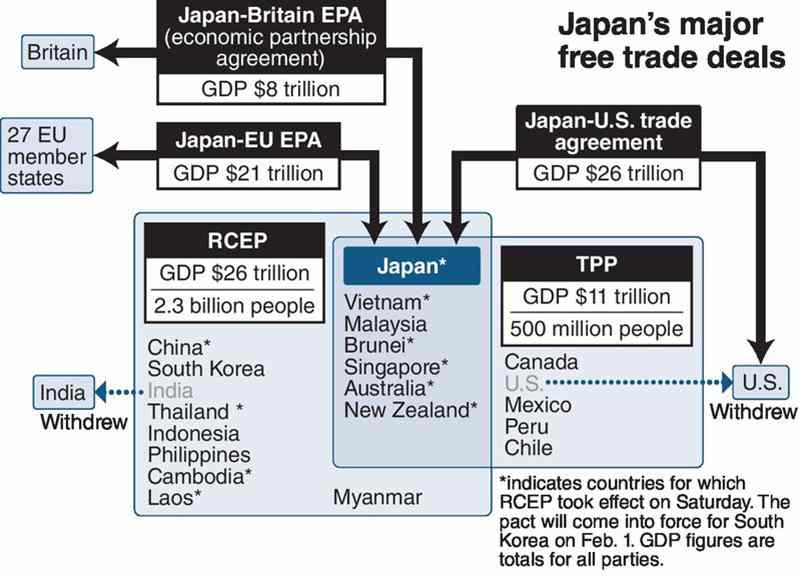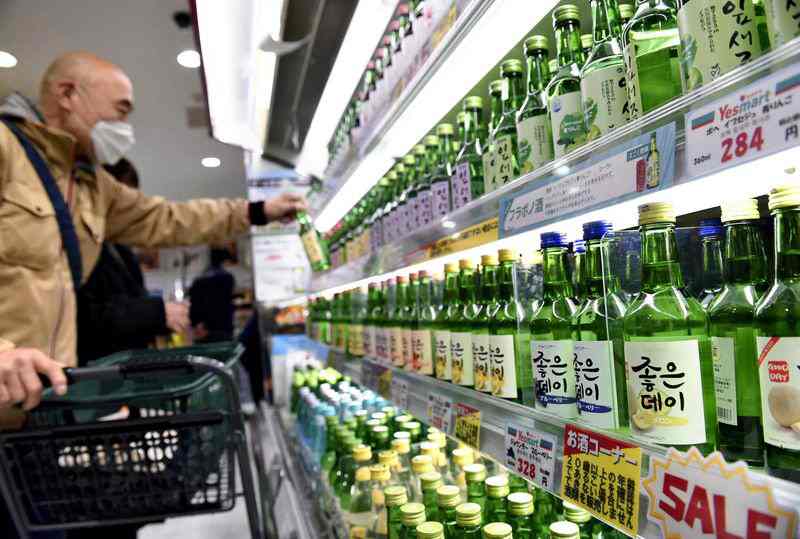
6:32 JST, January 1, 2022
The Regional Comprehensive Economic Partnership (RCEP), signed by 15 countries, took effect for 10 of those countries, including Japan and China, on Saturday.
RCEP signatory countries also include South Korea and the member states of the Association of Southeast Asian Nations. The pact is Japan’s first free trade agreement with China, and will also be its first with South Korea when RCEP takes effect for that country on Feb. 1. These developments raise expectations for expanded imports and exports. On the other hand, there is wariness that China, Japan’s largest trade partner, could take the dominant role in regional trade.
Japan’s GDP likely to grow 2.7%
Makgeolli and soju Korean liquors line the beverage shelves at Yesmart, a supermarket that sells South Korean foods in the Shin-Okubo district in Tokyo. A 63-year-old homemaker from Tokyo’s Adachi Ward, buying soju, said: “It’s easy to drink as the alcohol content is lower than that of Japanese shochu. If it were a little cheaper, I could buy soju more easily.”

Bottles of soju are seen on a shelf at Yesmart in Shinjuku Ward, Tokyo, on Wednesday. Tariffs on South Korean soju will be lowered in stages under the Regional Comprehensive Economic Partnership pact.
Tariffs on imports of the South Korean liquors will be cut in stages from Feb. 1. They are to be eliminated on the 21st year of the accord.
Although there are not many items for which tariffs will be cut significantly upon the effectuation of the pact, prices of imported goods are highly likely to go down over a period of several years to a decade.
RCEP will abolish tariffs on 91% of items. Its level of trade liberalization is not as high as that of the Trans-Pacific Partnership (TPP) agreement, which eliminates tariffs on almost all items, but the RCEP pact will be significant for Japan as its first free trade deal with China and South Korea.
Sumitomo Rubber Industries, Ltd. exports golf equipment under such brands as XXIO. “Japanese-made products are very popular in Asia, especially in South Korea. RCEP will be a boost for us,” a company official said.
In manufacturing, RCEP is expected to have a major impact with the elimination of tariffs on auto parts, whose exports to China amount to about ¥5 trillion a year, and tariffs on materials for batteries used in electric vehicles. The Japanese government estimates that the pact will lift the nation’s real gross domestic product by about 2.7%. The figure is larger than the government’s estimate of about 1.5% for the TPP pact. This is because many RCEP countries currently maintain higher tariffs than countries participating in the TPP.
ASEAN has also welcomed the creation of the giant economic zone. Many member states have already formed various free trade agreements, but each one has different procedures and rules regarding tariffs. Such a situation complicates operations for companies working across multiple borders. The RCEP pact is expected to facilitate cross-border trade by standardizing the rules within the region.
Le Quang Lan of the ASEAN Secretariat expressed hope that the pact will accelerate an economic recovery from the coronavirus pandemic by creating new opportunities and jobs for the people in the RCEP zone.
China looks to benefit
Interest in RCEP is also high in China, where the Commerce Ministry and other entities held sessions on the trade system under RCEP, with more than 160,000 people participating.
At a press conference on Thursday, Chinese Vice Commerce Minister Ren Hongbin referred to the effectuation of RCEP, saying, “It will closely link the two markets, domestic and international, and become a new driving force for economic growth.”
The remark appeared to imply China’s intent that if the integration of regional economies is promoted, it could become a way for Beijing to break the U.S.-led encirclement of China.
The RCEP pact sets rules, such as a ban on forcing companies to set up servers that store electronic data in countries they seek to operate in. A challenge will be whether China will strictly abide by such rules that restrict strong government interference in economic activities.
Meanwhile, the United States has been increasingly wary of China taking the lead in Asia under the RCEP pact. In November, 14 senators of the Republican Party sent a letter to the administration of U.S. President Joe Biden, saying that the RCEP deal will serve China’s interests. They urged the administration to seek a digital trade agreement in the Indo-Pacific region to counter China.
"Business" POPULAR ARTICLE
-

Tokyo Economic Security Forum to Hold Inaugural Meeting Amid Tense Global Environment
-

Keidanren Chairman Yoshinobu Tsutsui Visits Kashiwazaki-Kariwa Nuclear Power Plant; Inspects New Emergency Safety System
-

Imports of Rare Earths from China Facing Delays, May Be Caused by Deterioration of Japan-China Relations
-

University of Tokyo Professor Discusses Japanese Economic Security in Interview Ahead of Forum
-

Japan Pulls out of Vietnam Nuclear Project, Complicating Hanoi’s Power Plans
JN ACCESS RANKING
-

Tokyo Economic Security Forum to Hold Inaugural Meeting Amid Tense Global Environment
-

Keidanren Chairman Yoshinobu Tsutsui Visits Kashiwazaki-Kariwa Nuclear Power Plant; Inspects New Emergency Safety System
-

Imports of Rare Earths from China Facing Delays, May Be Caused by Deterioration of Japan-China Relations
-

University of Tokyo Professor Discusses Japanese Economic Security in Interview Ahead of Forum
-

Japan Pulls out of Vietnam Nuclear Project, Complicating Hanoi’s Power Plans




























